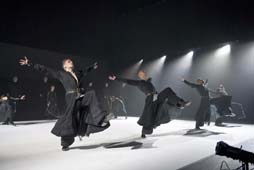
Jack Anderson
Tero Saarinen's Communal Austerity
 |
| Tero Saarinen Company’s “Borrowed Light,“ performed at BAM. (Left to right) Tero Saarinen, Heikki Vienola, Henrikki Heikkila, Carl Knif. Photo by Jack Vartoogian. |
"Borrowed Light"
Tero Saarinen Company and the Boston Camerata
Next Wave Festival
BAM Howard Gilman Opera House, 30 Lafayette Avenue, Fort Greene, Brooklyn
November 7-10, 2007 (closed)
Info.: (718) 636-4129
Reviewed by Jack Anderson, November 12, 2007
Tero Saarinen's "Borrowed Light" is a strange, impressive, and
sometimes disturbing musical and choreographic depiction of a community
locked together in a common faith. The tenets of that faith never become
explicit, although they are presumably religious. What interests this
Finnish choreographer is how force of convictions allows these people
to persevere.
Although his work is set to unaccompanied hymns of the Shakers, American viewers should probably forget most of what they know about actual Shaker life, especially in picturesque old New England communities. "Borrowed Light," seems to take place on some chilly tundra far from Massachusetts or even Maine. Erikka Turunen's drab costumes seem oppressively heavy. Mikki Kunttu's lighting is occasionally harsh, but more often shadowy, as if evoking a northern realm of almost perpetual winter.
Except for levels at the sides, the stage is empty. But Saarinen fills it with solemn songs and dances, artfully mingling his own troupe with the Boston Camerata, directed by Joel Cohen, so that it is sometimes difficult to distinguish singers from dancers.
Saarinen's community gathers together with heavy stamps, lurches, and effortful swings of the body. Although some movements are fast and arms can circle through the air, the impression is one of effort, rather than agility; gravity keeps pulling people downward, and even though the space around them stays literally empty, it appears to be filled with an invisible thickness that must be cut through.
Moving is endless labor in this community. The dancers always give the impression of struggling, yet their struggles lead only to further struggles. These people may well be bound in a collective attempt to save their souls, but salvation is never guaranteed, and so they labor on.
Many of the hymns, though fervent, sound gentler than the way the movements look, as if music for this community represented a promise or a consolation. Yet there are times when the verses goad or chide. "I have a soul to be saved or lost," one hymn says. Another describes "A golden chain that binds us all together." And groups wheel about the stage in endless circular patterns as the lyrics assert, "The great wheel is turning round." One can easily imagine these people wheeling round until they die.
Saarinen's community is imaginary: he invented it. Yet he makes us believe in its reality and, having invented it, he then choreographically regards it with the cool eye of an anthropologist, recording its customs but refusing to cast either an unambiguously positive or negative judgment upon it. Its dedication obviously fascinates him, but he neither extols its steadfastness nor condemns it for fanaticism.
This community, Saarinen may be saying, is fundamentally alien to us, its way of life is not ours; make of it what you can. Meanwhile, as we gaze in awe or consternation, these people diligently obey a hymn that exhorts them, "Press on, press on."
| museums | NYTW mail | recordings | coupons | publications | classified |
